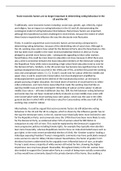‘Socio-economic factors are no longer important in determining voting behaviour in the
US and the UK.’
Traditionally, socio-economic factors including: social class, gender, age, ethnicity, region
and religion, has an impact on voting behaviour in the US and UK, demonstrating the
sociological model of voting behaviour that believes that primacy factors are important,
although this hypothesis has been challenged in recent times, because the extent of which
these factors respectively influence the way the electorate vote fluctuates.
Firstly, it could be argued that socio-economic factors are becoming unimportant in
determining voting behaviour, because of the diminishing role of social class. Although in
the US, working class voters have voted for the Democrat Party since the New Deal era, this
link has been more volatile in the most recent presidential election in 2016 as Trump
pledged to provide more factory jobs - subsequently appealing to blue-collar workers.
Nevertheless, this could be more down to education not class, because in 2016 there was
also a direct connection between the least educated members of the electorate voting for
the Republican Party while voters exceeding a high school level education tend to vote for
the Democrat Party. Similarly, in the UK social class has become less significant due to the
partisan dealignment that occurred in the 1960s and 1970s, as before this point the working
class and unemployed voters; C1, C2, D and E, would vote for Labour while the middle and
upper class; A and B, would vote Conservative, but class dealignment amplified by
embourgeoisement caused by the decline of the manufacturing sector, an increase in
people pursuing a higher education, the break down of barriers of social barriers to white-
collar professions, and more home ownership that made the working class feel like an
aspiring middle class and the consequent rebranding of Labour as New Labour to attract
middle class voters – all broke traditional class ties. Still, the link between voting behaviour
and social class has not been rendered entirely irrelevant as most middle class voters still
vote Conservative while most working class vote Labour, which was the case in the 2001
general election in which 40% of AB voters voted for Conservatives while over half of the
working class voted for Labour.
Alternatively, it could be argued that socio-economic factors do still determine voting
behaviour in the US and the UK to a degree, which is shown by the influence gender has on
the way the electorate votes. In the US, women have historically been more inclined to vote
for the Republican Party, and conversely since the 1990s they have been more likely to vote
for the Democrat Party, as evidenced when 54% of women voted for Bill Clinton in
comparison to only 41% of men. This could be explained by the Democrat’s support for
more progressive policies including female rights, for example they typically view abortion
laws more favourably, whereas Republicans tend to focus on male-dominated issues such as
gun rights. In the most recent presidential election of 2016, the ‘October surprise’ leaking a
videotape exposing President Trump’s misogynistic comments may have particularly swayed
some women to vote for Hillary Clinton instead. Nevertheless, the factor of gender in US
elections has been undermined by the arguably more influential factor of race, as despite
Trump’s sexist views a majority of white women still voted for him, showing the higher
importance race may have played. Meanwhile, throughout history in the UK women have
also tended to support the Conservative Party as a result of being more socially conservative
as they would have commonly stayed in the private domain of the home, thus exalting a




